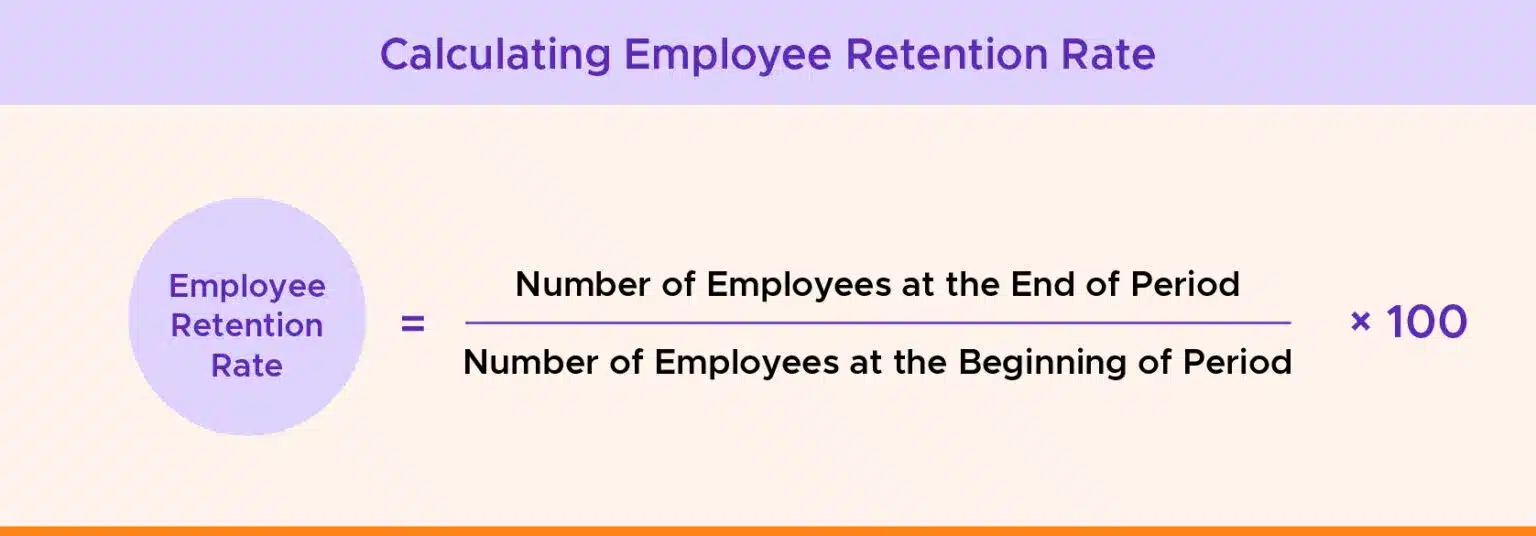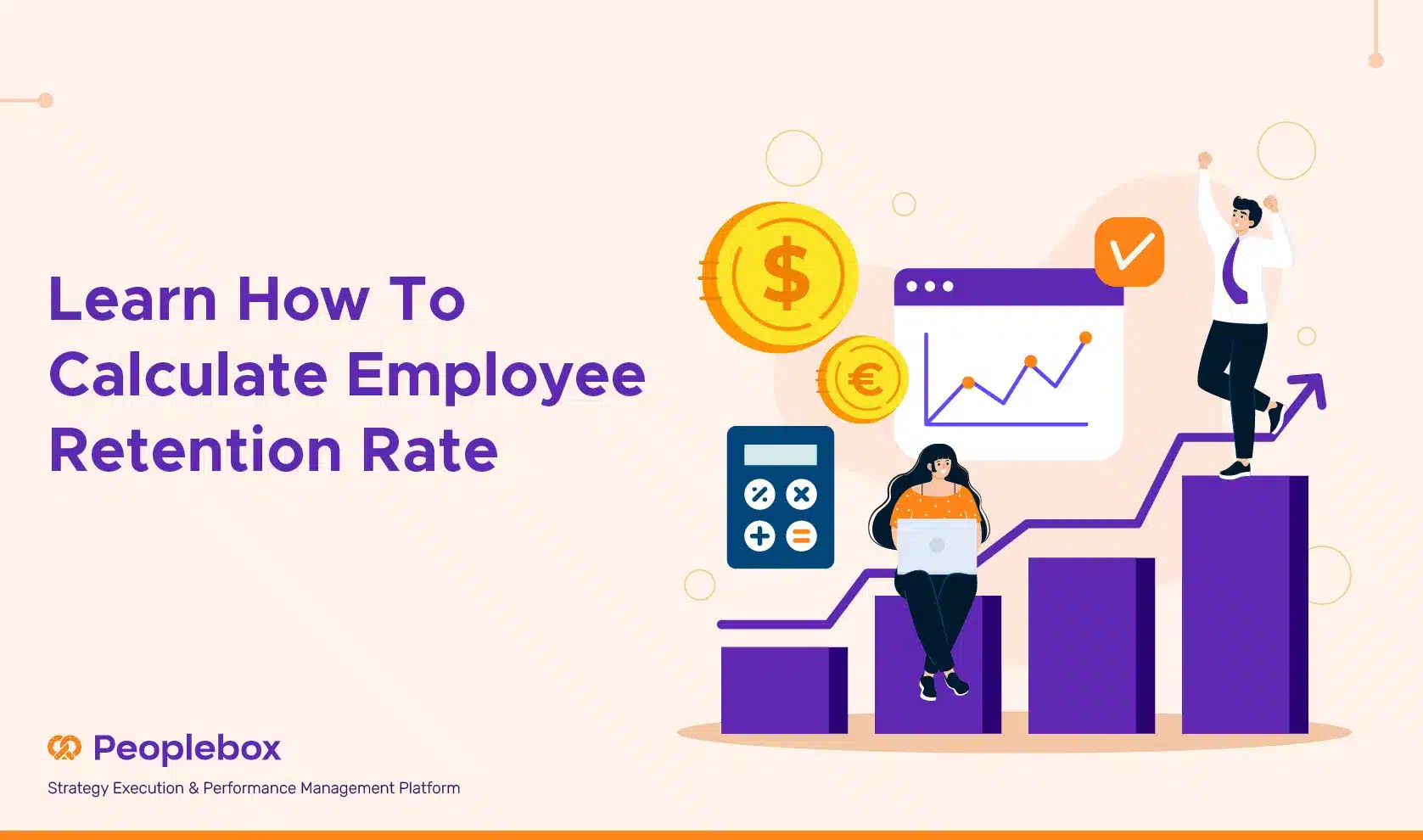Employee retention rate is a critical metric that determines the overall health and success of any organization. High turnover rates can lead to significant financial losses, decreased productivity, and a decline in company culture.
Understanding and calculating employee retention rate is crucial for identifying top performers and potential issues, and implementing effective retention strategies.
In this blog post, we’ll explain exactly how to calculate employee retention rate and share some tried-and-tested strategies for improving it.
TL;DR
Employee Retention Rate measures the percentage of employees who stay with a company during a specific period.
You can calculate the retention rate by:
👉 Determining the number of employees at the start of a period.
👉 Counting the number of employees who remained at the end.
👉 Dividing the number of retained employees by the starting number.
👉 Multiplying the result by 100 to get the ERR percentage.
Strategies for boosting employee retention rate include:
💡 Offer competitive compensation and benefits.
💡 Invest in employee development and career growth.
💡 Foster a positive work culture and environment.
💡 Prioritize work-life balance and employee well-being.
💡 Implement effective recognition and rewards programs.

What is Employee Retention Rate?
Employee retention rate is a metric that measures the percentage of employees who stay with a company over a specific period. It’s a key indicator of employee satisfaction, workplace culture, and overall organizational health.
It is the opposite of the employee turnover metric, which measures how many people have left during a period.
What is the Employee Retention Rate Formula?
To calculate the employee retention rate, you can use the following basic formula:
ERR = [(Number of Employees at End of Period / Number of Employees at Start of Period) x 100]
For instance, if you started with 40 employees at the beginning of the year and ended the last day of the period with 36, the calculation would be:
Retention Rate=( 36/40 )×100=90%
This metric helps understand the organization’s ability to retain talent and can inform strategies to improve employee satisfaction and engagement, ultimately reducing turnover costs and enhancing organizational stability.
Why is Retention Rate Important for Business Owners?
Calculating employee retention rate is crucial for several reasons that significantly impact an organization’s overall effectiveness and success.
Workforce stability
A high retention rate signifies a stable workforce, crucial for long-term success and growth.
For example, in a software development company with strong staff retention, employees who stay for several years gain deep expertise in company policies, work ethics, and standards.
This stability facilitates better future planning and enables tackling ambitious projects, confident in a reliable team.
Cost savings
Recruiting, hiring, and training new employees are expensive processes.
Retaining experienced employees eliminates these costs, allowing you to allocate resources to other critical areas, such as employee career development, ultimately fostering a more skilled workforce.
Productivity
Experienced workers typically outperform new hires who may be unfamiliar with company processes, culture, and goals.
For instance, in a manufacturing company, long-tenured employees understand the production steps, equipment, and quality standards thoroughly. Their expertise allows them to quickly identify bottlenecks, optimize workflows, and mentor new hires.
This leads to higher productivity and improved product quality compared to a constantly shifting workforce of inexperienced recruits.
Knowledge retention
Longer employee tenures contribute to the accumulation of institutional knowledge, benefiting the organization.
In a consulting firm specializing in a niche industry, consultants who have been with the firm for years develop extensive insights into client preferences and best practices. This expertise grows with each new assignment, giving your company a competitive edge.
Morale and engagement
High turnover rates are usually associated with poor morale and lack of job satisfaction among workers.
Conversely, a high retention rate fosters a meaningful work environment. Employees are more likely to work alongside supportive supervisors and dependable colleagues, creating a culture of security and positivity.
High morale translates into effective engagement, ensuring quality service delivery and improved sales performance.
Competitive advantage
Companies with high retention rates attract top talent and maintain a skilled workforce.
Consider two tech start-ups vying for the same talented engineers. Company A is known for its low turnover, positive work culture, competitive salaries, and professional growth opportunities. In contrast, Company B has a reputation for high turnover (Those Glassdoor reviews!).
Skilled engineers evaluating job offers are more likely to choose Company A, leading to a stronger, more capable workforce.
Customer satisfaction
Frequent personnel changes can negatively impact customer satisfaction, as clients prefer interacting with familiar employees.
Let’s picture an investment firm where clients have worked with the same account manager for many years:
👉🏼 During this given period, the account manager becomes familiar with the client’s financial situation, goals, and preferences.
👉🏼 Clients feel comfortable discussing their concerns and trust their personal advisors’ judgments.
This long-term relationship leads to higher customer satisfaction and loyalty, as clients know they can rely on a familiar and knowledgeable point of contact.
Overall, it is safe to say that calculating the employee retention rate and ensuring your employees are happy is very important to your bottom line. Let’s now see how you can calculate employee retention rate in your organization.
🧮 How to Calculate Employee Retention Rate?
Calculating your employee retention rate is straightforward. Just follow these five simple steps to determine how well your organization is keeping its employees.
Step 1: Choose Your Time Frame
First, decide on the time frame for your calculation.
Many organizations prefer to calculate retention rates annually, as this gives a more complete view of worker movement over the year. However, you can also measure retention quarterly or even monthly.
👉 Monthly calculations can help you spot sudden changes in employee separations, allowing you to make timely adjustments to policies.
👉 Annual calculations align with standard HR reporting cycles and provide a broader perspective on retention trends. Plus, most industry benchmarks are based on annual data, making it easier to compare your results.
Step 2: Count Employees at the Start of the Period
Next, find out how many employees you had at the beginning of your chosen time frame. This information can be obtained from payroll records or human resources data files.
Make sure to include all active employees on the first day of the period, regardless of their employment status (full-time, part-time, or temporary).
This number will be your starting point for the employee retention rate calculation.
Step 3: Identify Retained Employees
Now, determine how many employees stayed with the company until the end of the specified period.
This count should only include those who were employed at the beginning and are still with the company at the end.
Be sure to exclude any new hires made during the period, as you want to focus solely on the retention of your original workforce.
Step 4: Apply the Employee Retention Rate Formula
With your starting employee count and the total number of employees, who were retained you can now calculate the retention rate using the following formula:

For example, if your company had 200 employees at the start of the year and 150 of them remained at the end, the calculation would be:
Retention Rate =(150/200)×100=75%
This means that 75% of your workforce has been with you for the entire year.
Step 5: Compare Your Retention Rate to Industry Standards
After calculating your employee retention rate, compare it to industry benchmarks. For example, the average retention rate in 2021 was 47.2% (Bureau of Labor Statistics), but this varies by industry.
In hospitality, where turnover is high, a 47.2% retention rate would be unusually high since the average turnover rate is 73.8%.
Comparing your retention rate to industry standards will help you understand if you are retaining more or fewer employees than your competitors.
What is a Good Employee Retention Rate?
According to Matt Tenney, author of “Inspire Greatness: How to Motivate Employees with a Simple, Repeatable, Scalable Process,”:
“A retention rate of 90% or higher is considered to be a good retention rate, meaning organizations should strive for an average employee turnover rate of 10% or less.”
And, we agree! While the ideal employee retention rate can vary depending on the industry and company size, but generally, a retention rate of 90% or higher is considered excellent.
Tips and Best Practices to Improve Employee Retention Rate
Here are some effective tips and best practices to improve employee retention rates:
1. Offer Competitive Compensation
Conduct regular wage surveys to ensure that pay matches performance and market standards. Providing comprehensive benefits packages, including medical coverage, pension plans, and paid time off, can also make your organization more attractive to employees.
2. Invest in Employee Development
Continuous training programs are essential to impart new skills and keep employees engaged. Offering educational reimbursements or professional development grants, along with clear career paths and promotion opportunities, helps employees see a future within the organization.
3. Enhance the Onboarding Process
Develop a thorough onboarding program that integrates new hires into the company culture beyond just paperwork. Setting clear expectations and providing ongoing support during the initial months of employment are key to successful integration.
4. Foster a Positive Work Environment
Create a safe and comfortable workplace that promotes productivity. Encourage open communication to build trust among employees and offer flexible work arrangements, such as remote work options and flexible schedules, to support work-life balance. Gather constructive feedback through questionnaires and interviews to assess employee engagement.
5. Recognize and Reward Contributions
Establish a formal recognition program to celebrate outstanding performance. Regular feedback and praise for employees’ efforts and achievements, along with celebrating milestones and project completions, can significantly boost employee morale.
6. Focus on Employee Wellbeing
Implement wellness programs, such as gym memberships and mental health support, to promote overall well-being. Additionally, fostering an inclusive and respectful work culture that values diversity is essential for employee satisfaction.
7. Gather Employee Feedback
Conduct regular employee engagement surveys to understand their needs and concerns. Utilizing exit interviews can provide valuable insights into why employees leave and highlight areas for improvement.
With Peoplebox, conducting pulse surveys is a breeze! Try it out!
8. Manage for Retention
Train managers to be supportive leaders who guide and mentor their teams rather than micromanage. Cultivating a coaching culture where employees feel valued and empowered to share their ideas can enhance retention.
🥨 How Peoplebox Simplifies Employee Retention Rate Tracking
The best way to retain your employees is to ensure they are paid well, cared for, protected, and encouraged to grow and learn. But can you step in and enhance every individual employee experience?
In larger companies with thousands of employees, this is impractical. In smaller companies, it may be easier to execute but still tricky, as you’ll generally have smaller teams and more duties to get to.
You need an efficient talent management tool that fits your existing workflows and simplifies people management — giving your employees the same benefits but with half the effort from your end.
Peoplebox provides real-time updates and progress tracking to help managers and employees stay on track and make informed decisions about performance and engagement.
By leveraging the power of technology and data-driven insights, you can create a work environment that values, supports, and retains your most valuable asset — your people.
Ready to create a thriving workforce? Get in touch with us today!








